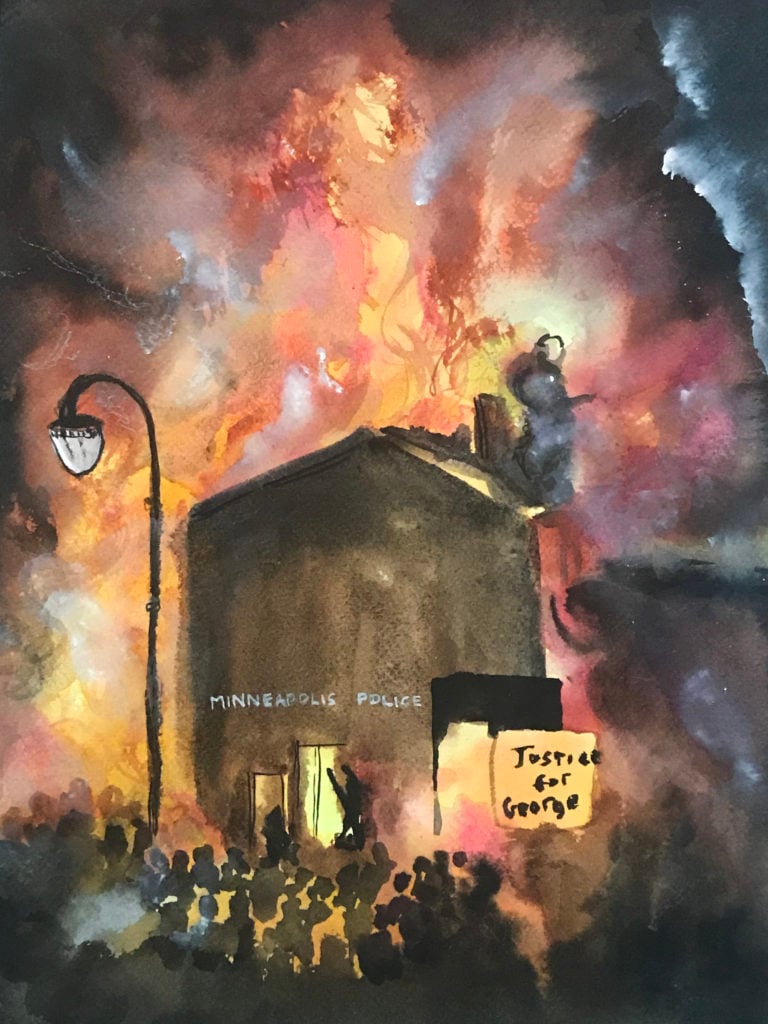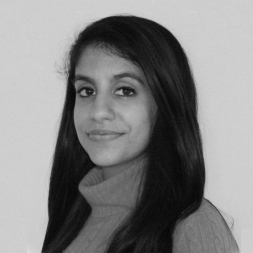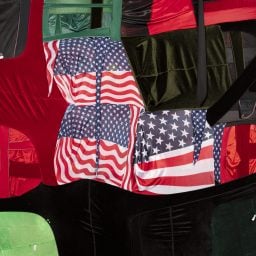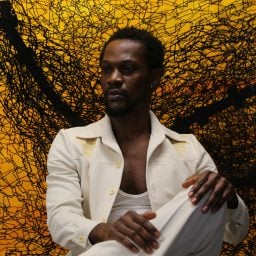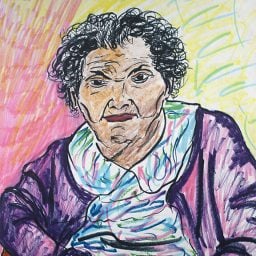Protesters filled the streets in cities across the United States this weekend to express fury over the recent deaths of innocent black Americans—George Floyd, Breonna Taylor, and Ahmaud Arbery—and the many who came before them, killed senselessly at the hands of police officers. Among the protesters were artists of all stripes, many of whom view activism as an important part of their practice. Below, 18 artists shared what they experienced while protesting this weekend.
Darryl Westly, Painter (New York)
There’s a realization that as a black artist you’ve been dealing with this your whole life. Your parents have dealt with it. Every name is etched onto this board that we all carry within our hearts. I always feel as though when you’re an artist of color, when you’re a black artist, you’re hyper-aware of how you move, of how people move around you, of oppression’s micro-transgressions.
When I heard about the death of George Floyd, I immediately experienced a sinking feeling of just realizing that this same scenario is playing out again, which was coupled with exhaustion and tiredness. There’s a sense of frustration around even having to try to explain the significance of all this to the uninitiated. There is also frustration in the expectation from people outside of the black community for how black people should be responding to this event. It’s like, “This is how you should react when you’re put on the ground and kicked.” The intent of a person of color can’t be gleaned from a simple movement of the hand or gesture of the body.
I went to the protests for myself, along with two of my white artist friends, Chris Rice and Emil Martirossian. I needed to go to hear some of the voices that aren’t the ones just running through the collective echo chamber of the internet. I went to understand that the people attending these marches are filled with a deep sense of empathy and they’re attending to understand that their lives—all our lives—are connected within these systems that have been created to stratify us and stop us from being able to understand one another. The real takeaway from all this is that there are police techniques in play that only benefit one section of the public. But trying to preserve a dead system isn’t enough just to maintain a false sense of order. I went to hear people walking and marching, to hear, “Black liberation! Black women’s liberation! Black trans liberation!” And to hear, “Say his name: George Floyd.”
Ann Lewis, Artist and Activist (Detroit)
My work focuses on the intersection of womxn’s rights, mass incarceration, and police brutality. I’ve been protesting this shit for years. It’s part of my practice. I’d been wrestling severe emotional fatigue this week from a deep dive into rape research for a project, but recognized I had to dig deeper and show up for folks. We have deeper wells of compassion and power than we realize. Every foot marching, every voice chanting is important right now. We need the numbers. White folks need to show up.
I saw the beauty and power of the Detroit community while protesting. I saw people practicing social distancing while also marching fiercely. Detroit is a powerful city with a tremendous history of racial abuse and trauma. Because of that history, the community is one of the strongest and most supportive I’ve ever witnessed. People were racing to pick one another up, defending storefronts, caring for one another. I also saw instigators. I saw a white man with no mask on screaming at the top of his lungs, carrying a massive knife, marching alone amongst the crowds. Perhaps he was there to start shit, perhaps he was just a lonely person needing to participate—I don’t know and can’t judge, but we kept our eyes on him.

Protestors in Foley Square march with a sign honoring George Floyd. Image courtesy Ventiko.
Candy Kerr, Artist, Embroiderer and Musician (Baltimore)
When I heard about what happened to George Floyd, my soul sank and met the souls of my ancestors. I went out the first night of protests in my city. I saw generations of trauma and pain pouring out of black people. I saw two black cops in the mix of 10 white cops, looking uncomfortable, and at least one cop of unidentified descent who was twitching a bit as insults were being hurled at him. The area smelled strongly of weed. A few white and light-skinned people were attempting to co-opt the space. I saw a pastor making demands of the police commissioner, trying to keep the peace. A helicopter circled overhead to read us our rights so that if they did make arrests all their bases were covered.
Saturday was my birthday and I chose to bathe in black joy. Sunday, I refueled. My soul holds joy and sorrow at the same time. This is a revolution—it’s born of oppression and made of chaos. I have no hope, but I have patience.
Marcus Leslie Singleton, Painter (New York)
I decided to go to the protests after thinking about what my parents, grandparents, and great grandparents went through in this country. I remember when I first found out I was black. That might sound crazy, but as a kid you’re just focused on doing kid things. You’re not thinking about race. I was playing basketball and Super Nintendo. I had a racist encounter at school when I was around five or six and my parents explained to me that sometimes people with darker skin get treated unfairly. When I heard them say that, I got that airless feeling in my chest that you get when you know something’s up. That’s how I felt at the protest. Hope is too passive. As a country, we can no longer afford the luxury of hope. Why are we still having to say black lives matter in 2020?
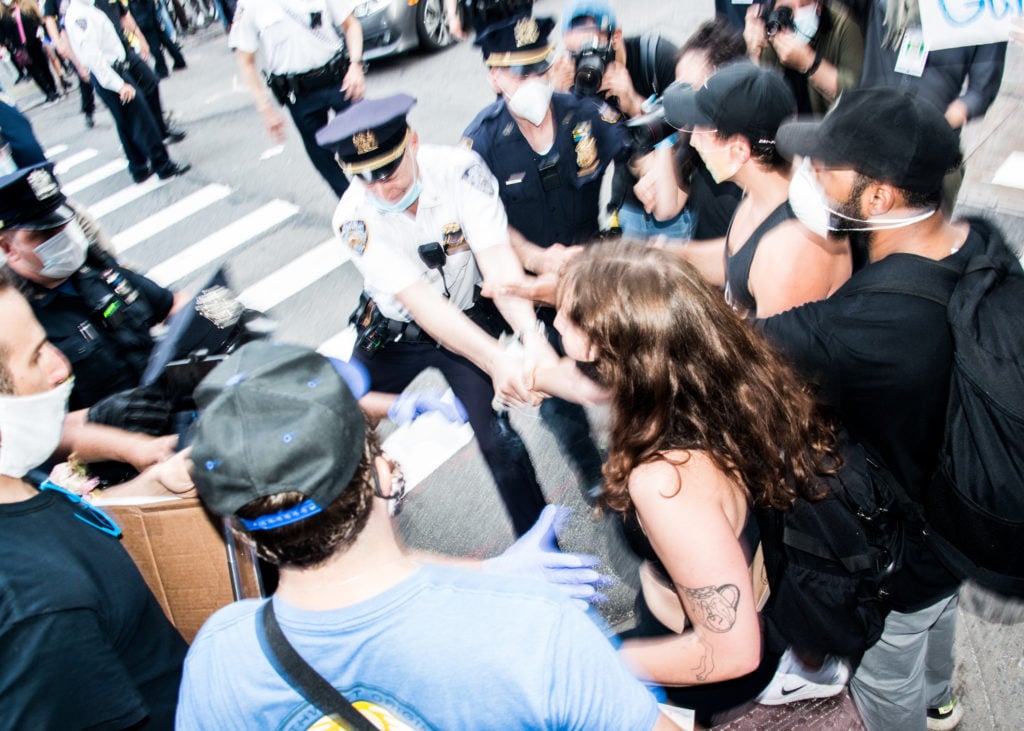
Police pull a woman off the sidewalk to arrest her for being on the street. Image courtesy Ruvan Wijesooriya.
Amy Khoshbin, Artist, Activist, and Educator (New York)
I’ve been protesting a long time because showing up raises awareness about these murders, shows solidarity, and creates a sense of community power. It feels empowering to move as a collective body. This is the first major protest since COVID-19 hit and it lit the resistance fire in my heart to see so many people showing up in the struggle towards change together, even though we’ve been so isolated recently.
I saw brutality. Violence. Rage. Joy. Catharsis. People power. The irony of protesting police brutality is that the cops continue their unnecessary violence towards unarmed protestors, throwing them to the ground, arresting them, pepper spraying, driving cars into peacefully chanting crowds. I’ve seen cop vans lit on fire in retaliation. I’ve seen beautiful moments of dancing, chanting, taking the streets for hours. I chanted the names of those who died recently at the hands of the cops: George Floyd, Breonna Taylor, Tony McDade, Ahmaud Arbery. I hope these actions put pressure on City Council in the next few weeks, as they set their budget for the year, towards defunding the $6 billion dollar NYPD budget, creating an NYPD hiring freeze, getting cops out of schools, cutting NYPD’s expansion into non-police activities, and so much more.
Yashua Klos, Artist (New York)
I wanted to see and be seen with others who are demanding a more just society. I also wanted a constructive way to mourn the recent killings of innocent black people by the police. I wanted release from my own fears. On Saturday night, it felt energizing to exercise freedom of speech as a community. Systemic racism realizes that it will be checked from here on—we are not waiting any longer for the system to check itself. Black and brown folks are the most vulnerable to a healthcare system that marginalizes us and state-paid law enforcers who murder us. The system, as is, kills us both slowly and quickly. This is all our problem. The desperate acts of rioting and protesting makes this pain impossible to ignore.
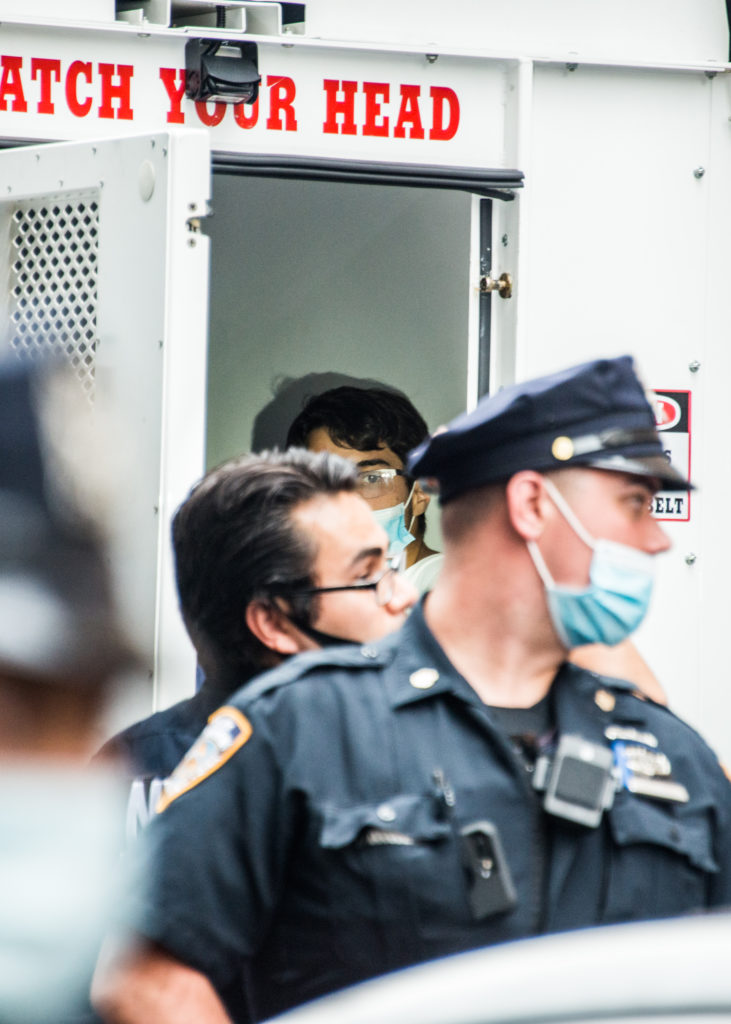
A teenager in custody. Image courtesy Ruvan Wijesooriya and The Cut.
Onyedika Chuke, Artist and Professor at the Cooper Union (New York)
A nearly four-minute video of a brutal police beating during a peaceful protest was remotely deleted from my phone or corrupted via my Google Cloud account. I was on the front lines of a peaceful protest, marching up West 14th Street between 6th and 7th Avenues. The group was composed of racially diverse members, with those identifying as white occupying the front as a buffer between the marchers and possible police interaction. As we marched, a white man between the ages of 30 and 35 ran through the crowd and a fight started. The protesters chased him onto the sidewalk. I stood back to document what I saw, hoping to provide an accurate account of what was happening. About eight NYPD officers swarmed the area, zeroing in on the man. The protesters made way for what we assumed would be an arrest, but instead it turned into a beating. They threw him on the ground, punching and kicking him as he lay on the sidewalk. Eventually, our arms were locked together in an attempt to stop other officers from entering what seemed to be a tag-team group MMA match rather than a lawful arrest. They eventually zip-tied him and picked him up. His face was swollen from multiple blows. Reds and pinks everywhere. Blood streaming down. We are all speaking, but just not together or towards the same goals. I hope we can change that.
Ebony Brown, Artist (New York)
I participated in the protest that took place at the Barclays Center on Friday evening. It was necessary for my emotional and mental wellness to let off some steam instead of suffering in silence after repeatedly watching the traumatic, inhumane murder of George Floyd. I wanted to come together with people in my community to send the message that African Americans will no longer tolerate police brutality. The chants were more aggressive than I anticipated. I was surprised to be surrounded by so many white people holding Black Lives Matter signs while yelling, “NYPD, suck my dick!” It felt cathartic to yell and scream. Being from a family with several police officers active and retired, it was uncomfortable for me to chant, “Fuck the police!” but in that moment, I realized my own discomfort didn’t matter because another unarmed black man was strangled by a heartless policeman while desperately uttering the words, “I can’t breathe.” Now I fully understand how necessary it was for NWA to make that song in 1988. The tension was high from the moment I arrived. I left when a friend told me he saw the police preparing to use riot gear.
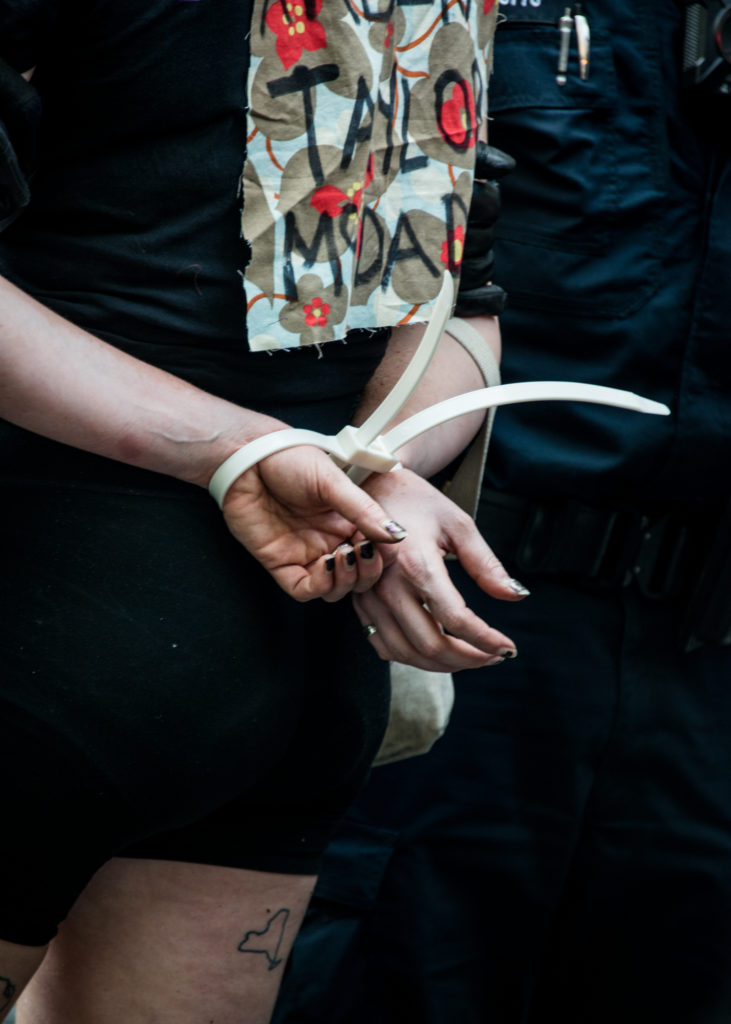
A young protestor is arrested. Image courtesy Ruvan Wijesooriya and The Cut.
Ventiko, Conceptual Artist (New York)
Since March 21, I have been riding my bicycle through New York City documenting New Yorkers in quarantine for a photo series called From the Outside Looking In. I understand that my ability to cycle through the American coronavirus epicenter was made easier because of the color of my skin. For me to stay silent, to not acknowledge my white privilege and not show up, especially now, is wrong. When I rode up to Friday’s protest at Foley Square, I burst into tears. People of all races gathered, risking their own health and potentially lives, to call for justice for the murder of George Floyd, and other black people, at the hands of white police. It was tragically beautiful. It was also tense and everyone could feel it. Our country is ripping open and exposing how broken it really is. Cameras—including mine—are covering every moment of it. I want true equality. I want black and brown people to be able to live their lives without the constant fear of being murdered.
Fariha Róisín, Artist and Writer (New York)
People need to understand this is not an isolated incident. Black folks, indigenous folks—have the highest rate of murder at the hands of police. This happens regularly. So, it’s not about a one-time resource, a one-time protest you post about on Instagram. It’s about divesting from capital, from the concept that one life is worth more than another. If you want a good life, do you think that a good life is worth more than the life of another person entirely? That’s what capitalism does to you, it makes you think you deserve nice things, no matter the cost to human life.
There needs to be a concerted effort to remember that this is our responsibility—if we are non-indigenous/non-black folks—to do this work consistently. If you are rich and come from wealth, begin to talk to your families about divesting from their wealth because no matter where that money is from, it’s probably been accrued from exploitation. Not hard work. No one is rich from hard work—or else we’d have laborers or the people that built this country dripping in cash. This is systemic. We need to start seeing its roots.
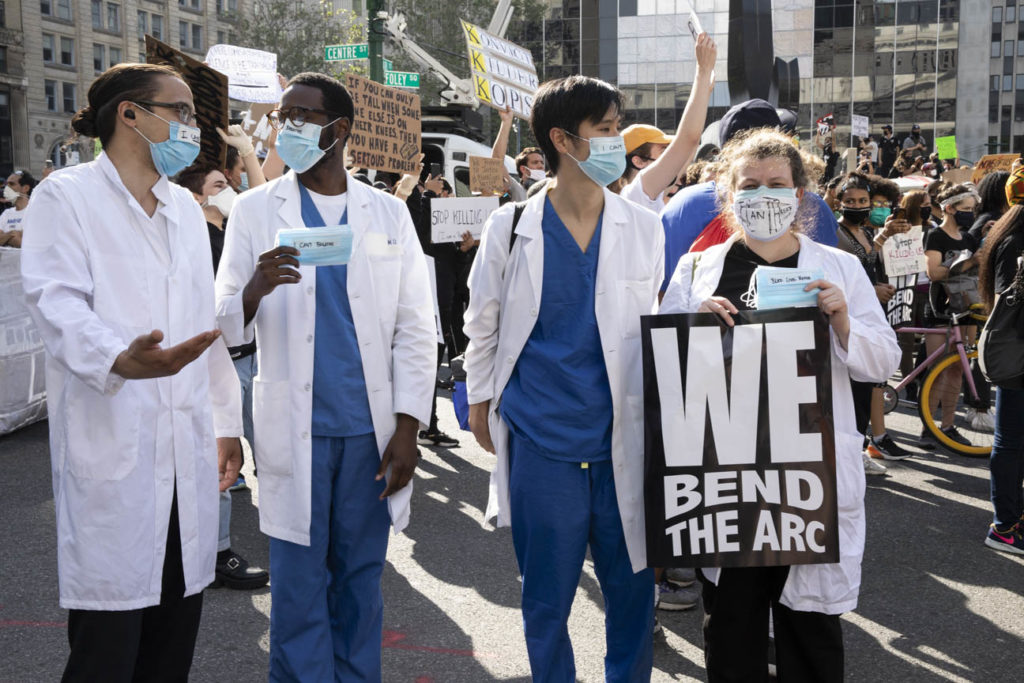
Medical workers gather in Foley Square. Image courtesy Ventiko.
Zachary Tye Richardson, Performance Artist (New York)
I have devoted my work to a therapeutic process for the effects of anti-queer blackness. But time and time again, black people are not afforded the chance to begin the healing process without another life taken.
America’s taste for black people’s blood is quenchless. The video of George Floyd’s murder broke me and many around the world. I do not feel “hope” and I’m infuriated by the semantics of the word. Joining these protests was the most invigorating thing I’ve done in years. The march in Brooklyn on May 29, 2020 is something I will never forget. In a crowd of mostly white allies, I felt a sense of ownership of their privilege. Being biracial, I understand the privilege that I carry in the complexion of my light skin—I am the digestible black person in American society. But the consensus in this protest was that this is beyond us. This is for our future and our kids’ kids. I, like many artists, convinced myself that my advocacy through my practice was enough. It is not. I challenge everyone to get out and get your voices heard. Racism is a vicious cycle that can only be stopped in solidarity. Silence is the ultimate violence. Black suffering is loud and unwavering. We have tried peace; this time, we shake the table.
Marian Bailey, Artist (Philadelphia)
I decided not to attend the protests. I was feeling too anxious about being in a large crowd during a pandemic. I instead opted to walk around my very white neighborhood with a Black Lives Matter sign, with a few people that were wearing Black Lives Matter shirts. During my walk, I saw a lot of uncomfortable people. A handful of people voiced their support and one white man yelled from his truck that black lives, in fact, do not matter. But I felt empowered while walking through my neighborhood. It felt good to confront people who continue to opt out and not care about the injustice felt by so many people across the nation. Keep going, keep feeling, keep speaking up. And for all of the people that continue to be silent, we see you.
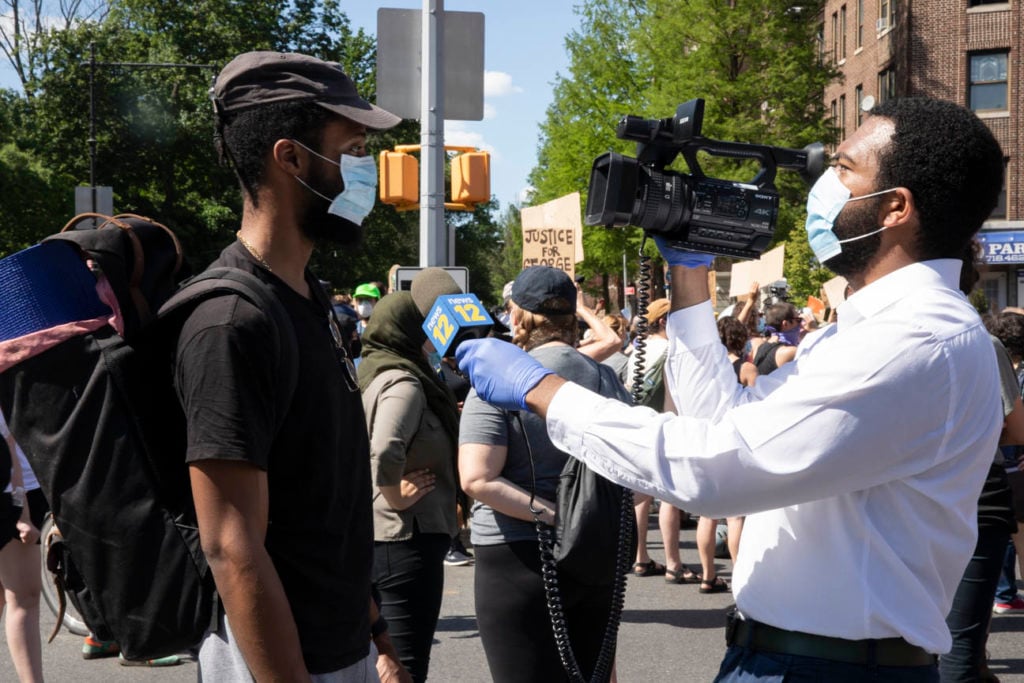
A protestor being interviewed in Flatbush. Image courtesy Ventiko.
Tamar Zohara Ettun, Artist (New York)
I am originally from Jerusalem and on Saturday, Iyad al Hallaq, an autistic Arab man, was shot seven times in his chest by the border police when he was on his way to work at a special-needs school in the old city in Jerusalem. Iyad al Hallaq’s murder feels to me very related to the murders of George Floyd, Ahmaud Arbery, and Breonna Taylor. I went to three protests in Brooklyn this weekend: in Flatbush, Grand Army Plaza, and Barclays Center. It was mostly young people, holding signs and chanting, and keeping their distance. It’s quite amazing to see the complex choreography of people gathering in a big group, expressing rage and anger, while at the same time demonstrating a sense of care not to touch anyone next to them, all while moving. It was powerful to see this exercise in control which didn’t, in any way, mute the power of raw emotions.
Kambui Olujimi, Painter (New York)
There’s a popular notion that riots are violent spontaneous overflows of emotion, usually in response to an incident. They are not. These actions are the result of persistent and untenable conditions. They are not a swansong of reason, but rather a transference of matter, like breath into snow—what Dr. King calls “the voice of the unheard.”
I’ve been focused on what I call the silent-state riot, the surreal and absurd space of inequity that generates these proverbial shifts in matter. I’m interested in these “outbursts” as telltale signs, not just of the socio-economic conditions they belie, but of an invisible psychological terrain that oppressed peoples must negotiate daily. I investigate connections between the vernacular of this psychological terrain, and the aspiration of the common riot.
The Sublimation Project is an interdisciplinary project that looks to shift the dialogue around riots. I am currently looking for support of the project. My recent works on paper and writings are a spontaneous response to our current American condition. These works are only a couple days old and I’m still learning them but I do know that I wanted to make something that would not allow us to forget this moment in the years to come.
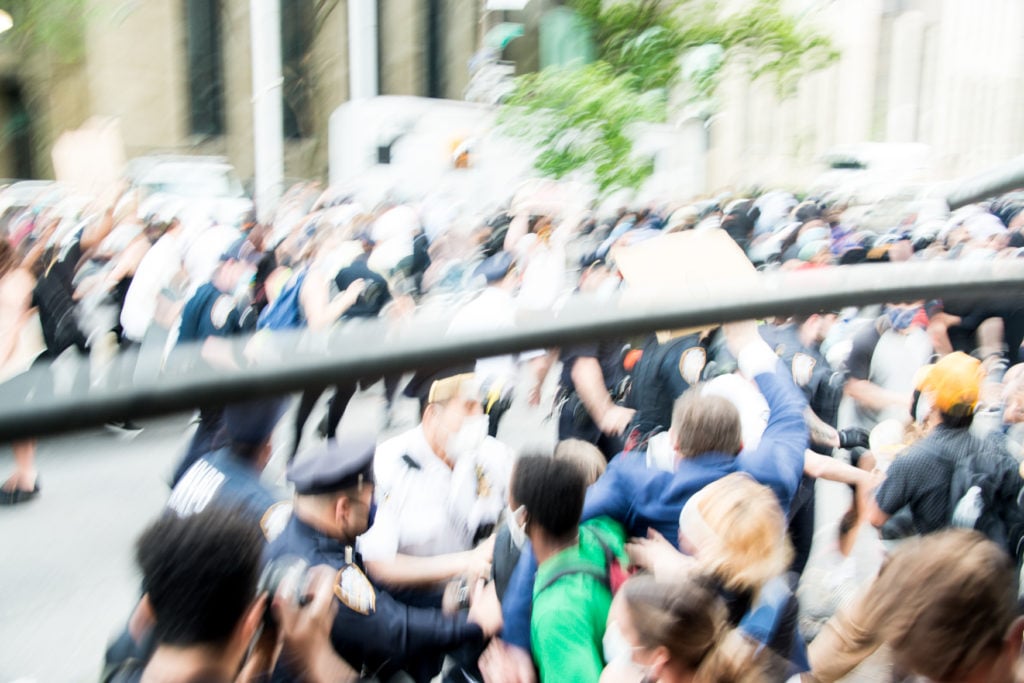
Policemen prevent protestors from crossing Canal Street. Photo courtesy Ruvan Wijesooriya and The Cut.
Kate Rath, Digital Artist (Philadelphia)
I want people to know that being an anti-racism ally is a lifelong learning process and not a point of enlightenment that white people can reach by crafting the perfect heartfelt Facebook status. White people need to listen to black people without trying to be the savior. I’m talking to all white people, but I’m mostly talking to myself.
I attended the Solidarity Against Police Terrorism Protest at the Philadelphia Art Museum and the march to City Hall that followed. I saw Food Not Bombs passing out bread. I saw a person with a huge bottle of GermX circling the crowd, offering it to everyone. I saw people spraying sunscreen on strangers’ shoulders from a safe distance. I saw a crowd of people sitting down peacefully in an intersection to stop two Philly police buses from making their way to the next block, where other protesters were surrounded by police and SWAT teams. I saw private property with corporate tenants get vandalized, but I didn’t see aggression towards human beings until the police began corralling groups of people and shoving protesters.
I have the privilege of being a white person in a country that was built to serve white people and oppress anyone who is not. If I don’t listen to and support the people being oppressed, then I am directly contributing to their oppression.
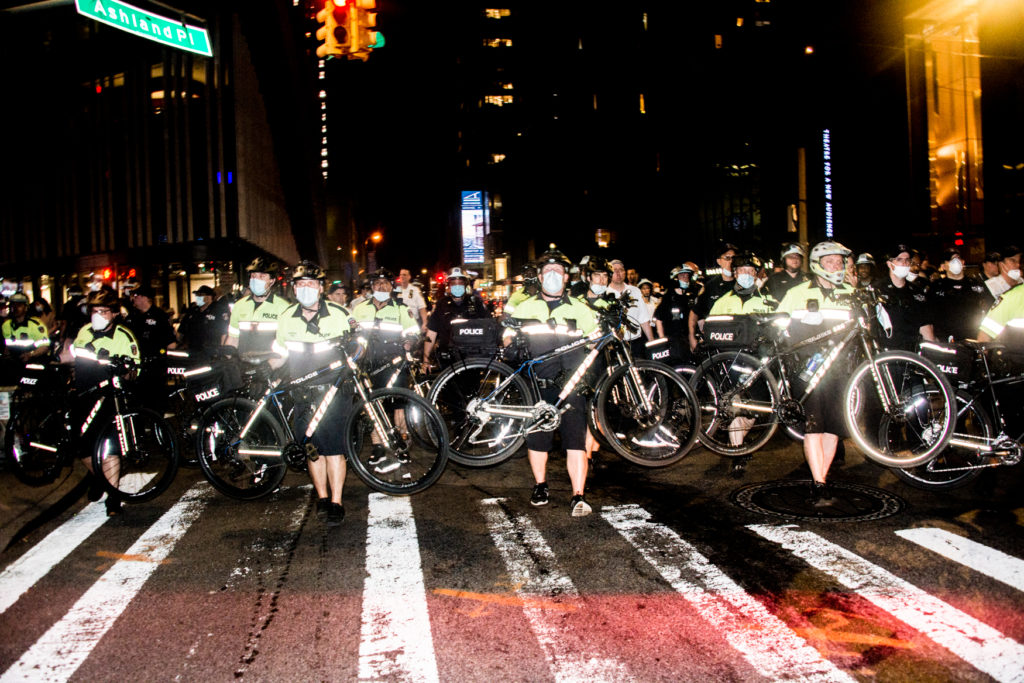
Policemen form a barricade with their bikes. Image courtesy Ruvan Wijesooriya and The Cut.
Christen Clifford, Artist (New York)
I went to the Queens Black Lives Matter / Fuck The Police protest on May 30th in Jackson Heights, where I have lived for over 15 years. I saw hundreds of people chanting “No justice, no peace!” “The people united / will never be defeated!” I saw signs that said “Filipinos for BLM” and “Asians Americans for Black Lives Matter.” They said, “Stop killing black people.” They said, “Black trans lives matter” and “Black liberation matters” and “Racism isn’t born, it’s taught” and “Justice for Breonna Taylor”, and “Tony McDade.” I saw police with fancy new equipment in their light blue helmets, with face shields, in their vans and with taser guns. I saw friends, neighbors, and artists. Leaders telling us to march, and people handing out snacks, water, and masks. I felt angry, happy, sad, energized, old, nervous about catching the virus, and hopeful.
Miriam M, Artist, Poet, and Educator (San Francisco)
I am a brown, queer, indigenous (Chichimeca Guamare) poet, artist, community educator, and worker currently living as a guest on occupied Tuibun Ohlone land in the East Bay, California. There are many roles to play within tangible solidarity. I chose to donate to the Minnesota Freedom Fund that pays bail for protestors arrested during demonstrations and shared resources relating to other local bail funds. I also use digital collage art as a vessel for solidarity and created a piece for our beloved George. Through art, the images of our lost loved ones are held in love and light, to uplift their transitioning spirits and to support ours as we process this loss.
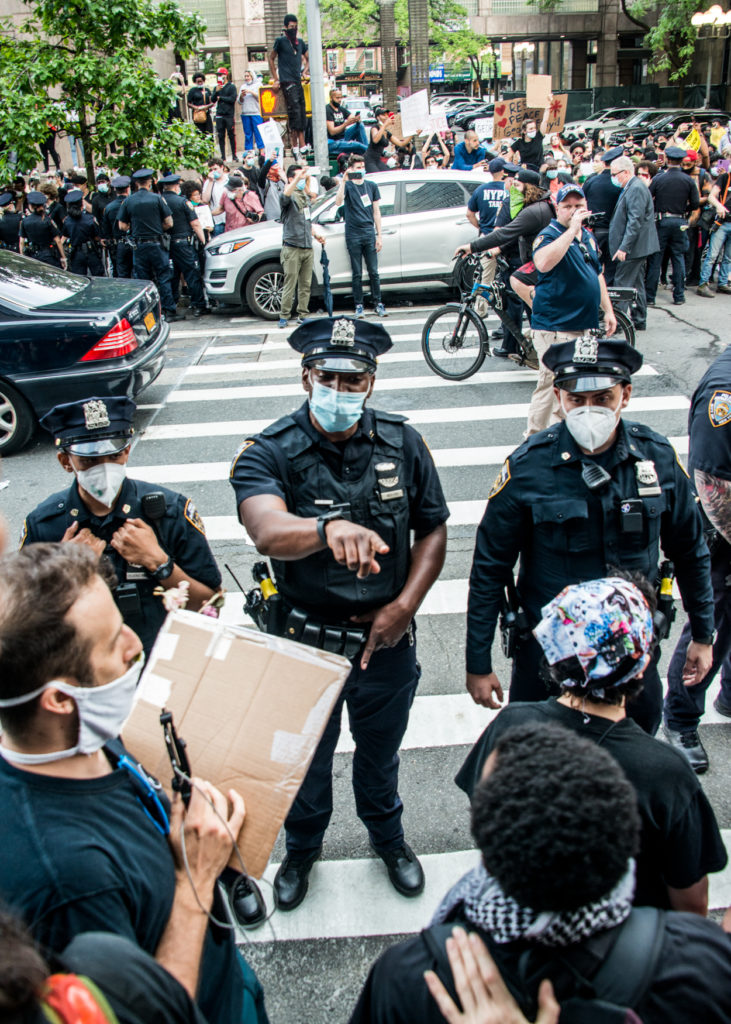
Policemen surrounding protestors. In the background, an NYPD officer holds up a Sony face detection video camera. Image courtesy Ruan Wijesooriya and The Cut.
Ruvan Wijesooriya, Photographer and New Media Artist (New York)
I was on assignment for The Cut on Friday. When I walked north to Foley Square on Center at 3:45 p.m., it was empty, so I kept walking. I immediately saw a man in his early 20s being arrested. Then another guy a half-block up. Both were people of color. The protest hadn’t started yet. I walked back to Foley at 3:55, and it was packed. I hadn’t been around more than three people in nearly three months, and managed to get over the COVID-19-crowd scare fast. Everyone was wearing a mask and we were outside.
The main protest was cathartic. Nobody was looking for a fight—just to express themselves and their disgust for police brutality aimed at black people. When we got to Canal Street, the police blocked the crowd from crossing and backed up a prisoner van. We’d landed right outside “The Tombs” or House of Detention, where they take you when you get arrested.
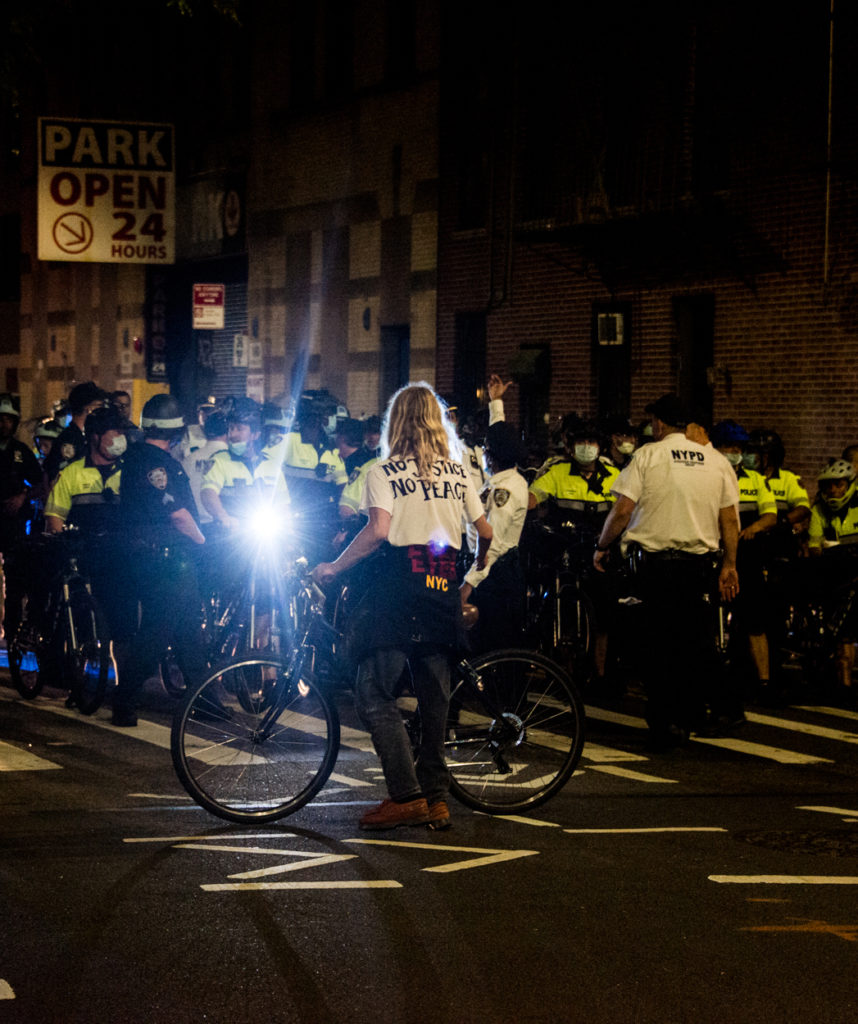
A protestor stands before 60 or 70 policement. Image courtesy Ruan Wijesooriya and The Cut.
All of a sudden there were seven, maybe eight different cops around us. A few younger people refused to get off the street and they were immediately arrested. It wasn’t going to be the kind of protest I was hoping for. There was one undercover NYPD “press” team cruising around the crowd and there were a few in uniform using the Sony tourist video camera with group photo facial recognition.
Close to Walker Street, they sprayed mace, and many ran away. It rained, the crowd thinned out more, and it felt like the police were going to surround everyone and take them into The Tombs. At some point, an MTA driver walked off of a bus transporting police and protestors. Protesters cheered. I left for Brooklyn just as it was getting dark.
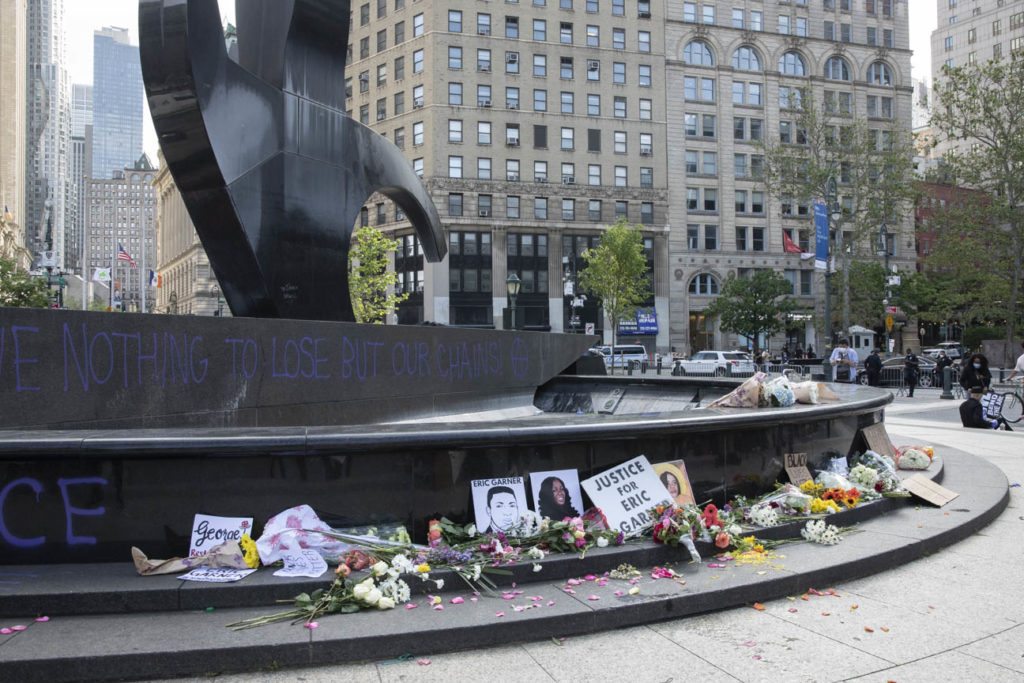
Tributes to black Americans who were killed fill Foley Square. Photo courtesy Ventiko.
Toward the end, the Tour de France of the NYPD showed up. A hundred dudes on bikes. I felt like I was in a Revolutionary War reenactment where muskets and bayonets had been replaced by billy clubs and bicycles. I saw one of them shoving a teenage girl with his billy club before trying to land it on someone else. The feeling that so many other people with camera phones are filming police brutality, but lacking the agency to do anything about it, sunk in. There are way more violent policemen than protestors, most of whom were—like myself—walking in the only direction they could take to get home. I kept walking, wondering what the fuck just happened, knowing that the police wanted, more than anything, to win.
Follow Artnet News on Facebook:
Want to stay ahead of the art world? Subscribe to our newsletter to get the breaking news, eye-opening interviews, and incisive critical takes that drive the conversation forward.
